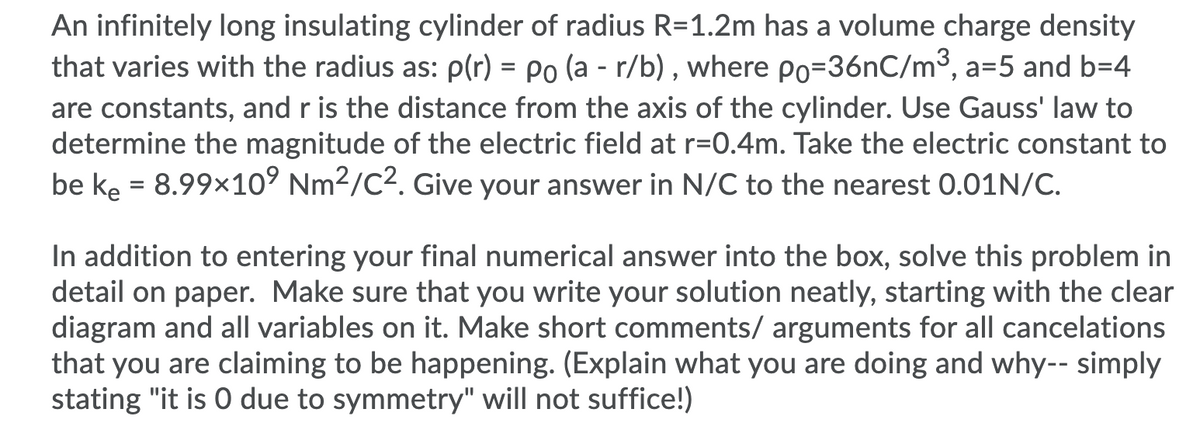An infinitely long insulating cylinder of radius R=1.2m has a volume charge density that varies with the radius as: p(r) = Po (a - r/b) , where po=36nC/m³, a=5 and b=4 %3D are constants, and r is the distance from the axis of the cylinder. Use Gauss' law to determine the magnitude of the electric field at r=0.4m. Take the electric constant to be ke = 8.99×10° Nm2/C2. Give your answer in N/C to the nearest 0.01N/C. In addition to entering your final numerical answer into the box, solve this problem in detail on paper. Make sure that you write your solution neatly, starting with the clear diagram and all variables on it. Make short comments/ arguments for all cancelations that you are claiming to be happening. (Explain what you are doing and why-- simply stating "it is O due to symmetry" will not suffice!)
An infinitely long insulating cylinder of radius R=1.2m has a volume charge density that varies with the radius as: p(r) = Po (a - r/b) , where po=36nC/m³, a=5 and b=4 %3D are constants, and r is the distance from the axis of the cylinder. Use Gauss' law to determine the magnitude of the electric field at r=0.4m. Take the electric constant to be ke = 8.99×10° Nm2/C2. Give your answer in N/C to the nearest 0.01N/C. In addition to entering your final numerical answer into the box, solve this problem in detail on paper. Make sure that you write your solution neatly, starting with the clear diagram and all variables on it. Make short comments/ arguments for all cancelations that you are claiming to be happening. (Explain what you are doing and why-- simply stating "it is O due to symmetry" will not suffice!)
Physics for Scientists and Engineers: Foundations and Connections
1st Edition
ISBN:9781133939146
Author:Katz, Debora M.
Publisher:Katz, Debora M.
Chapter25: Gauss’s Law
Section: Chapter Questions
Problem 43PQ: The nonuniform charge density of a solid insulating sphere of radius R is given by = cr2 (r R),...
Related questions
Question
answer is not zero

Transcribed Image Text:An infinitely long insulating cylinder of radius R=1.2m has a volume charge density
that varies with the radius as: p(r) = Po (a - r/b) , where po=36nC/m3, a=5 and b=4
are constants, and r is the distance from the axis of the cylinder. Use Gauss' law to
determine the magnitude of the electric field at r=0.4m. Take the electric constant to
be ke = 8.99x10° Nm2/C2. Give your answer in N/C to the nearest 0.01N/C.
In addition to entering your final numerical answer into the box, solve this problem in
detail on paper. Make sure that you write your solution neatly, starting with the clear
diagram and all variables on it. Make short comments/ arguments for all cancelations
that you are claiming to be happening. (Explain what you are doing and why-- simply
stating "it is 0 due to symmetry" will not suffice!)
Expert Solution
This question has been solved!
Explore an expertly crafted, step-by-step solution for a thorough understanding of key concepts.
Step by step
Solved in 2 steps with 2 images

Knowledge Booster
Learn more about
Need a deep-dive on the concept behind this application? Look no further. Learn more about this topic, physics and related others by exploring similar questions and additional content below.Recommended textbooks for you

Physics for Scientists and Engineers: Foundations…
Physics
ISBN:
9781133939146
Author:
Katz, Debora M.
Publisher:
Cengage Learning


College Physics
Physics
ISBN:
9781285737027
Author:
Raymond A. Serway, Chris Vuille
Publisher:
Cengage Learning

Physics for Scientists and Engineers: Foundations…
Physics
ISBN:
9781133939146
Author:
Katz, Debora M.
Publisher:
Cengage Learning


College Physics
Physics
ISBN:
9781285737027
Author:
Raymond A. Serway, Chris Vuille
Publisher:
Cengage Learning